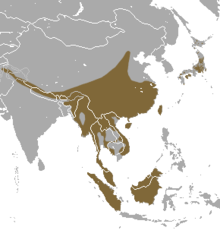Masked palm civet
| Masked Palm Civet | |
|---|---|
 |
|
| Scientific classification | |
| Kingdom: | Animalia |
| Phylum: | Chordata |
| Class: | Mammalia |
| Order: | Carnivora |
| Family: | Viverridae |
| Subfamily: | Paradoxurinae |
| Genus: |
Paguma Gray, 1831 |
| Species: | P. larvata |
| Binomial name | |
|
Paguma larvata (Hamilton-Smith, 1827) |
|
 |
|
| Masked palm civet range | |
The masked palm civet or gem-faced civet (Paguma larvata) is a civet species native to the Indian Subcontinent and Southeast Asia. It is classified by IUCN in 2008 as Least Concern as it occurs in many protected areas, is tolerant to some degree of habitat modification, and widely distributed with presumed large populations that are unlikely to be declining.
The genus Paguma was first named and described by John Edward Gray in 1831. All described forms are regarded as a single species.
In recent times, masked palm civets were considered to be a likely vector of SARS.
In morphology the masked palm civet resembles other palm civets, but does not have spots or stripes. Its fur is reddish to grey, and it has a black and white facial mask. Its tail is more than two-third the length of head and body. It has three mammae.
The mask consists of a prominent white stripe stretching from nose to forehead (sometimes extends farther but has greatly reduced thickness) that halves a black mask that extends laterally to the far edges of the cheeks and caudally up the forehead, past the ears, and down the back of the neck before stopping just under the shoulder blades. The eyes are surrounded by white fur that can vary from faint, incomplete outlines to well-defined . The lips, chin, and throat are white. In some, white stripes of fur, comparable to sideburns on humans due to shape and location, curve up from the throat. These curves vary in thickness and have ends that terminate either in small blotches at the ear base or large blotches that surround the base of both darkly furred ears.
No matter which coat it sports, masked palm civet's feet are always dark, often black, and the melanism usually extends partway up the legs in varying distances and intensities depending on the individual. The end of a masked palm civet's tail is sometimes darker than the majority of its coat. This difference in pigmentation can vary from a few shades darker than its coat to solid black and can cover a fourth to half of the tail.
...
Wikipedia

